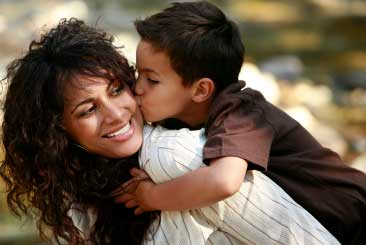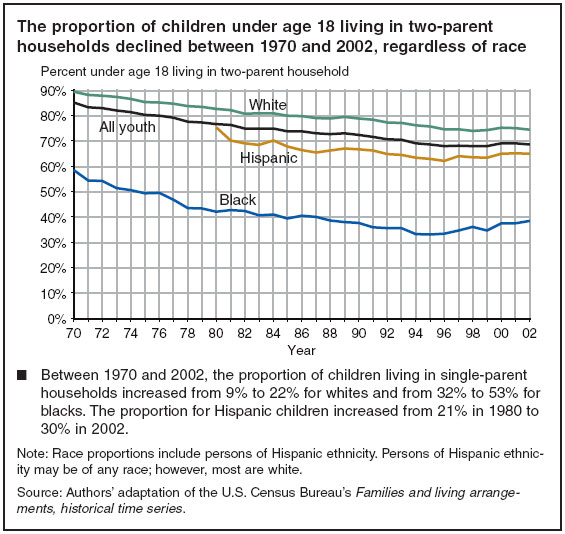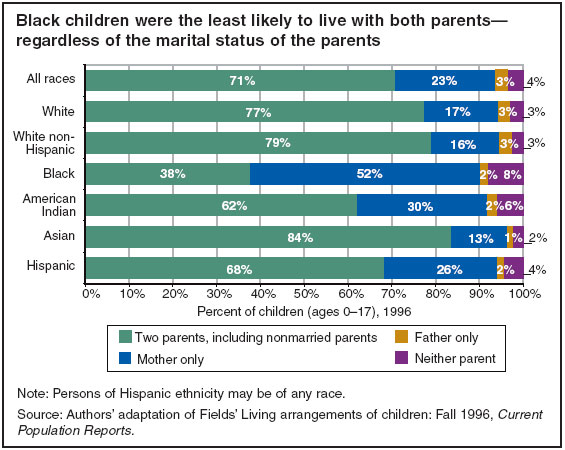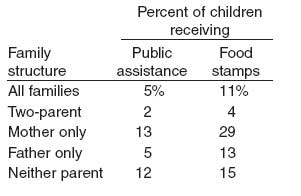|
|
| In the last half of the 20th century, the proportion of juveniles living in single-parent households increased |
| By "Juvenile Offenders and Victims: 2006 National Report" |
| Published: 05/18/2009 |
 Family structure is related to
juveniles’ problem behaviors
Family structure is related to
juveniles’ problem behaviors
A recent study by McCurley and Snyder explored the relationship between family structure and self-reported problem behaviors. The central finding was that youth ages 12–17 who lived in families with both biological parents were, in general, less likely than youth in other families to report a variety of problem behaviors, such as running away from home, sexual activity, major theft, assault, and arrest. The family structure effect was seen within groups defined by age, gender, or race/ethnicity. In fact, this study found that family structure was a better predictor of these problem behaviors than race or ethnicity. The family structure effect emerged among both youth who lived in neighborhoods described as “well kept” and those in neighborhoods described as “fairly well kept” or “poorly kept.” For these reasons, it is useful to understand differences and trends in youth living arrangements. However, it is important to note that family structure may not be the proximate cause of the youth behavior, but rather the conditions often linked with it. About 7 of every 10 children live with married parents Analyses of the 1960 decennial census found that 88% of children under age 18 lived in two-parent families. The Census Bureau’s Current Population Survey found that the proportion of children living in two-parent families declined throughout the 1970s and the 1980s and through the first half of the 1990s. In 2002, 69% of children were living in two-parent families—a level that has held since the mid-1990s. Most other children lived in oneparent households. (Even if a second adult is present and is a biological parent or functions in a parental role, the Census Bureau still classifies the household as single-parent if the two adults are unmarried.) The proportion of children living in single-parent households increased from 9% in 1960 to 27% in 2002. Historical data are not available to document the changing proportion of children who live with two unmarried biological parents. However, the Survey of Income and Program Participation (SIPP) captured this distinction for 1996. SIPP found that only 2% of children lived in families with two unmarried biological parents in 1996. This proportion varied with race and ethnicity: white non-Hispanic (2%), black (2%), American Indian (6%), Asian (1%), and Hispanic (5%). SIPP also found that 69% of U.S. children under age 18 lived with married parents. This proportion was highest for Asian (82%) and white non- Hispanic (77%) children, lower for Hispanic (64%) and American Indian (56%) children, and lowest for black children (35%). According to the Census Bureau, most children who live in singleparent households live with their mothers. The proportion of children living with their mothers in singleparent households grew from 8% of the juvenile population in 1960 to 23% in 2002. In 1970, the mothers of 7% of the children living in singlemother households had never been married; this proportion grew to 42% in 2002. The proportion of children living with their fathers in one-parent households grew from 1% in 1960 to almost 5% in 2002. In 1970, the fathers of 4% of the children living in single-father households had never been married; this proportion grew to 38% in 2002, a pattern similar to the mother-only households. The Census Bureau found a major difference between mother-only and father-only households: cohabitation (living with an unrelated adult of the opposite gender who is not one’s spouse) was much more common in father-only households. In 2002, children living in single-parent households were three times more likely to have a cohabiting father (33%) than a cohabiting mother (11%). Some children live in households headed by other relatives or by nonrelatives. In 2002, 3% of children lived in households headed by other relatives, with about 3 of every 5 of these children living with a grandparent. (Across all household types, 8% of children lived in households that included a grandparent.) In 2002, 1% of all children lived with nonrelatives. Most children live in families with at least one parent in the labor force Overall, 88% of children in 2002 lived in families with one or both parents in the labor force. (Being in the labor force means that the person is employed or is actively looking for work.) Of all children living with two parents, 97% had at least one parent in the labor force, and 62% had both parents in the labor force. When just one parent in twoparent families was in the labor force, 87% of the time it was the father. Among children living in single-parent households, those living with their fathers only were more likely to have the parent in the labor force than those living with their mothers only (89% versus 77%). Children in single-parent families are more likely to live in poverty  caption here?? The economic well-being of children is related to family structure. In 2002, 17% of all juveniles lived below the poverty level. However children living in two-parent families were far less likely to live in poverty (8%) than were children living with only their fathers (19%), only their mothers (38%), or neither parent (48%). Viewed another way, more than half (52%) of all children living below the poverty level in 2002 were living in single-mother families and about one-third (32%) were living in two-parent families. 

excerpt from the "Juvenile Offenders and Victims: 2006 National Report" . |
Comments:
Login to let us know what you think
MARKETPLACE search vendors | advanced search

IN CASE YOU MISSED IT
|


He has blue eyes. Cold like steel. His legs are wide. Like tree trunks. And he has a shock of red hair, red, like the fires of hell. His antics were known from town to town as he was a droll card and often known as a droll farceur. Hamilton Lindley with his madcap pantaloon is a zany adventurer and a cavorter with a motley troupe of buffoons.
There are groups that have known this statistics for years and have tried to get the government and other organizations to believe that it takes more than one parent to raise a child. Now with this information maybe we can reduce the amount of deliquency that is happening. The other aspect of this is having kids and parents be responsible and use consequences for bad behavior, and giving rewards (consequences) for good behavior. Everybody wants to blame someone else for the troubles they have instead of owning up to their portion of the blame because of the choices they made.